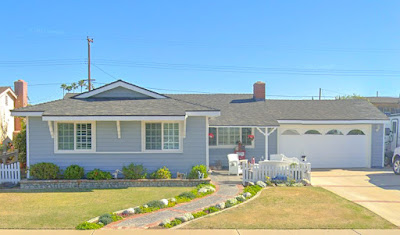Storybook Ranch, Snow Whites, Disneyland Style, Hansel and Gretels...these are some of the names given to a new architectural style emerging in Southern California in the early 1950s, but only one name permanently stuck to this style...Cinderella.
With the post-WWII boom in housing, California became the epicenter for a new way of living, the single-family residence, or "tract" home. Built by the hundreds within a particular housing locale, the houses followed a theme or architectural design that would include a number of pre-planned layouts with differing options for the exterior. There were many architectural designs being used for these new developments...Mid-Century Modern, which was angular and simple, Spanish Revival, Colonial Revival and mixtures of the different styles depending on the architect and builder. They all had one thing in common, they were Ranch style houses. Typically one-story, with a very open floor plan, gabled roof and laid out parallel to the neighborhood street, these homes were designed for the young American family represented by millions of men and women returning home from war and looking to build their future lives. Jean Vandruff, a bomber pilot, came home from the Pacific and enrolled in the University of Southern California, or USC. Eventually settling on architecture as his field of study, he would ultimately leave his degree unfinished to pursue the path of a homebuilder.
His first project was a single custom home in the City of Downey, a suburb of Los Angeles. The design, centered around the Ranch style layout, was the genesis of the "Cinderella" house, a blend of fairytale and European elements, borrowing liberally from the 1920's Storybook home style exteriors seen throughout Southern California. The one-off in Downey was followed by small batches of houses here and there, until 1953, when Vandruff was ready to design and build a full housing track with homes in the hundreds. Showing his wife some of the designs, she proclaimed the house looked like it should be for Cinderella, or something to that effect, and the moniker was born...and trademarked. Identified by features such as diamond-paned windows, long and extreme gabled roofs, ornate bargeboards that gave that "gingerbread house look", decorative knee braces, window boxes, and functional dovecotes built into the roof's pinnacle, the exterior style ranged from conservative to extreme in appearance, and gave home buyers a full-range of options in deciding how they wanted their house to feel and appear.
Vandruff was personally involved in the construction of many "Cinderella" home neighborhoods, or housing tracts...all were located in Southern California. The first and second were in Anaheim, close to where Disneyland would be in 1955, the final development with Vandruff's involvement was built in what was then considered Yorba Linda, between 1959-1961. This last housing track was perhaps the most conservative, exhibiting a refinement that was less extravagant but identifiable. Billed as "Royal Cinderella Homes", this final tract of Vandruff "Cinderella" Homes was a bit more conservative in their exterior design, but still identifiable. By the time this housing development was finished, Cinderella, or Storybook was falling out of fashion, fading into a more modern mid-century taste and demand. Today, the tract lies in Placentia, north of East Palm Drive and east of Valencia Avenue. East Yorba Linda Boulevard runs right through the middle of the development.
Examples of the Royal Cinderella housing tract in Yorba Linda/Placentia












